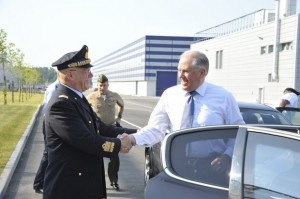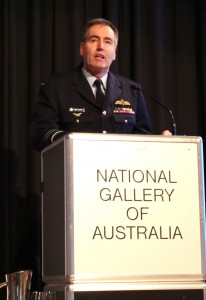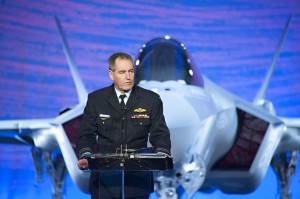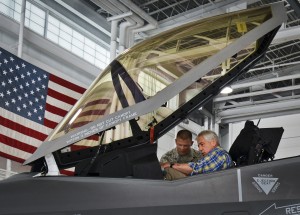2014-07-29 by Robbin Laird
On July 24, 2014, the first two Australian F-35s were on display and an official ceremony held to mark the event.
Two visitors to the event highlighted its importance and provided context.
The first was Frank Kendall, U.S. Under Secretary of Defense for Acquisition, Technology & Logistics, and the second was the RAAF Chief of Staff Air Marshall Geoff Brown.
Kendall has been focusing on the core role of partners in the program, and has done so recently in Italy at the Italian FACO facility and at the Australian event held in Fort Worth.

Earlier, on July 18th, Kendall met with the Italian Chief of Staff of the Air Force and with the Italian Armaments Director at the Italian Cameri facility, where F-35s are being assembled, wings manufactured, and a future sustainment facility evolving.
The Italian sustainment center might be joined at some point in the future with an Australian version of the same, although it is in Japan that an Asian FACO is being built, but with Asian sustainment centers along with European sustainment centers, the integrated airpower built around the F-35 as a global enterprise can emerge and evolve.
On the occasion of the roll out of the Australian F-35s, Kendall noted that:
Today, we celebrate a milestone in the U.S.-Australia partnership, a partnership built on strength, friendship, and technological innovation.
We join Australia, as one of our original partners, to celebrate this roll out and the numerous Australian contributions to the Joint Strike Fighter program.
For both our nations, this program represents an exponential leap in capability on the cutting edge of technology — and an integral component of our ongoing joint commitment to stability and peace in the Asia-Pacific.
And in a press release, Lockheed Martin focused on the two Australian aircraft which were the centerpiece for the event:
The aircraft, known as AU-1 and AU-2, are scheduled to undergo functional fuel system checks before being transported to the flight line for ground and flight tests in the coming months.
The jets are scheduled to be delivered to the Royal Australian Air Force later this year, and will be based at Luke Air Force Base, Arizona, where they will be used for Australian and partner country pilot training.
Earlier this year, I attended a seminar held by the Williams Foundation in Canberra, Australia where the focus was upon the future of air combat, with a special focus upon the F-35.

At that event, two F-22 pilots, one of whom is as well an F-35 pilot, provided insights into the break from traditional capabilities to fifth generation re-norming of airpower.
One was Australian and one was a Marine. A second speaker from the USMC discussed how the Marines were looking to integrate the F-35 into the overall evolution of the integrated force structure of the Marine Corps known as the MAGTF.
Air Marshall Brown spoke at that event and highlighted how he saw the evolving airpower transition associated with the F-35. At that event, Brown underscored that a shift from 4th to 5th generation fighters was not simply a transition in technologies but a “generational shift for everybody involved.” And clearly a key reason to acquire the F-35 is to get on the right side of generational change.
History tells us some things with relative certainty about air combat operations in 2025 and beyond. Importantly, it tells us that technologies will have evolved markedly by 2025, making it essential to acquire capabilities with future growth. 5th generation capabilities, such as the F-35 Joint Strike Fighter, offer a quantum leap in air power capabilities over their compatriots,
The missions they will undertake may not be new, but the capabilities 5th generations fighters bring will vastly change the character and effectiveness of how the missions are undertaken.
In his remarks in Fort Worth, marking the roll out of the first two Aussie F-35s, Brown focused on the way ahead, and how procuring the F-35 was simply the start of the effort; the real work rests in leveraging the impact of the new air combat capability throughout the Aussie force and in working with coalition partners.
“For me, the most impressive thing about the aircraft is what it brings to the fight in terms of situational awareness and decision dominance…not just for the pilot sitting in the F-35 but fro the entire Joint and Combined air, land and maritime forces deployed in and around the area of operations.”
Clearly, Brown focused upon the trigger and multiplier effect of the F-35 on the overall transformation of the Australian combat force.

“The F-35 will be a catalyst for evolution and in some areas revolution for both the Royal Australian Air Force and for the Australian Defence Force.”
But this will not happen simply by buying the aircraft. It will require a culture change and significant training in shaping an innovative path built by combat experience, and cross-learning with allies.
“Transitioning to a fifth generation fighter will challenge us to step outside our comfort zones and question past habits. The RAAF will partner and work closely not only with our sister services – the Royal Australian Navy and the Australian Army – but also with the USAF, USN, and USMC to learn, leverage and exploit those intrinsic 5th generation opportunities.”
Lest someone miss the point about the cultural shift and the rupture, which the F-35 fleet can provide, Brown went on to pound home the point.
We are introducing into service a revolutionary capability and our evolution as a force must align with the opportunity this offers us. The F-35 does not replace anything.
If I looked at the F-35 as a replacement for the Hornet or the Super Hornet in Australian service, I would undermine from day one the real capability of this aircraft.
Like any revolutionary capability, its potential to generate effects beyond the mainstream will have far reaching impacts in any future application.
I view the F-35 as a platform that can operate across the spectrum from tactical to strategic or anywhere in between as required. It will be the key node in enabling our new fluid force concepts.”
And in recognition that leaders like Secretary Hagel and Frank Kendall are working hard to deal with the Greek Chorus of F-35 commentators:

“I thank the leaders of the US Department of Defence, and their equivalents in the Partner nations for their superb efforts over many years, and their fortitude and vision to see through the difficult birth of the F-35 which will provide a key pillar for Australian defence and security over the coming decades.”
Brown was very clear in his remarks both in Canberra and Fort Worth, but what can be missed is another revolutionary aspect of the F-35 as a global fleet.
What is envisaged is not an interdependent air combat system, but an integrated air combat system.
And if commonality is maintained – and commonality for the core combat systems is currently the reality — then the data and communications links provide an integrated combat force of F-35 pilots spearheading defense operations.
It also means that a rainbow fleet can be deployed where F-35 partners can work together where there is the need or the political will.
For example, both the Netherlands and Australia see the need to involve assets in the current post-Malaysian Ukrainian situation to secure the crash site. With the F-35 future fleet, Australia could send a four ship F-35 force to marry up with the Dutch and be supported by a Dutch maintenance capability supplemented by Aussie maintainers. Rainbow fleets will provide an important political tool matching a variety of anticipatable settings for 21st century operations.
As we argued earlier about the potential for the F-35 in a future setting such as Ukraine:
The multi-mission capabilities of the aircraft means that a small footprint can bring diversified lethality to the fight. An F-35 squadron can carry inherent within it an electronic attack force, a missile defense tracking capability, a mapping capability for the ground forces, ISR and C2 capabilities for the deployed force and do so in a compact deployment package.
In addition, an F-35 fleet can empower Air Defense Artillery (ADA), whether Aegis afloat or Patriots and THAAD Batteries, the concept of establishing air dominance is moving in a synergistic direction. An F-35 EW capability along with it’s AA and AG capability will introduce innovate tactics in the SEAD mission. Concurrently, the F-35 will empower U.S. and Allied ADA situational awareness. The current engagement of the IDF employment of their Irion Dome in conjunction with aviation attacks is a demonstration of this type of emerging partnership being forged in battle.
To get a similar capability today into the Area of Interest would require a diversified and complex aerial fleet, whose very size would create a political statement, which one might really not want to make.
With an F-35 enabled ground insertion force, a smaller force with significant lethality and flexibility could be deployed until it is no longer needed for it is about air-enabled ground forces. A tiltrotar enabled assault force with top cover from a 360 degree operational F-35 fleet, whether USMC, USN, USAF or allied can allow for the kind of flexibility necessary for 21st century warfare and operational realities.
What is happening at Cameri, at Fort Worth and in Australia can shape the future of integrated coalition operations.
For our Special Reports focused on Australia and Italy see the following:
https://sldinfo.com/cameri-italy-and-the-f-35-special-report/
For an Australian report on the Brown visit see the following:
http://www.abc.net.au/news/2014-07-25/f35-joint-strike-fighter-production-line/5623628


